OAuth 2.0 Support
- Overview
- OAuth 2.0 authentication flow
- Scenario description
- Mapping of external user into ThingBoard internal user structure
- OAuth 2.0 configuration parameters
- HaProxy configuration
- Next steps
Overview
ThingsBoard allows you to provide Single Sign On functionality for your customers and automatically create tenants, customers or subcustomers using external user management platforms, that supports OAuth 2.0 protocol.
A list of platforms which supports the OAUth 2.0 protocol: Google, Okta, Auth0 etc.
OAuth 2.0 authentication flow
ThingsBoard supports the Authorization Code grant type to exchange an authorization code for an access token.
Once user returns to the ThingsBoard client via redirect URL, the platform will get the authorization code from the URL and use it to request an access token from the external user management platform.
Using the basic mapper or custom mapper external user info object will be converted from external platform into ThingsBoard internal OAuth 2.0 user and then the regular ThingsBoard authorization flow will happen.
Scenario description
In this sample we are going to use Google for the authentication. User is going to be logged into the Tenant and Tenant name is going to be equal to the users email. If Tenant does not exist in the system, the new Tenant will be created.
As a second step we are going to add a new external provider for authentication - Auth0. In this case User is going to be logged into the Tenant which name is going to be equal to a user email domain name. Additionally, for every user we are going to create a new Customer and Customer name is going to be equal to a user email.
To map those external user infos from Google and Auth0 platform we are going to use built-in basic mapper.
If basic mapper functionality will not fit your business needs, you can configure the custom mapper so that you are able to add an implementation that fits under your specific needs.
Login with Google
To use Google OAuth 2.0 authentication platform for Login, you need to set up a project in the Google API Console to obtain OAuth 2.0 credentials.
Please, follow the instructions on the OpenID Connect page to configure the OAuth 2.0 Client. After completing the instructions above, you should have a new OAuth Client with credentials consisting of a Client ID and a Client Secret.

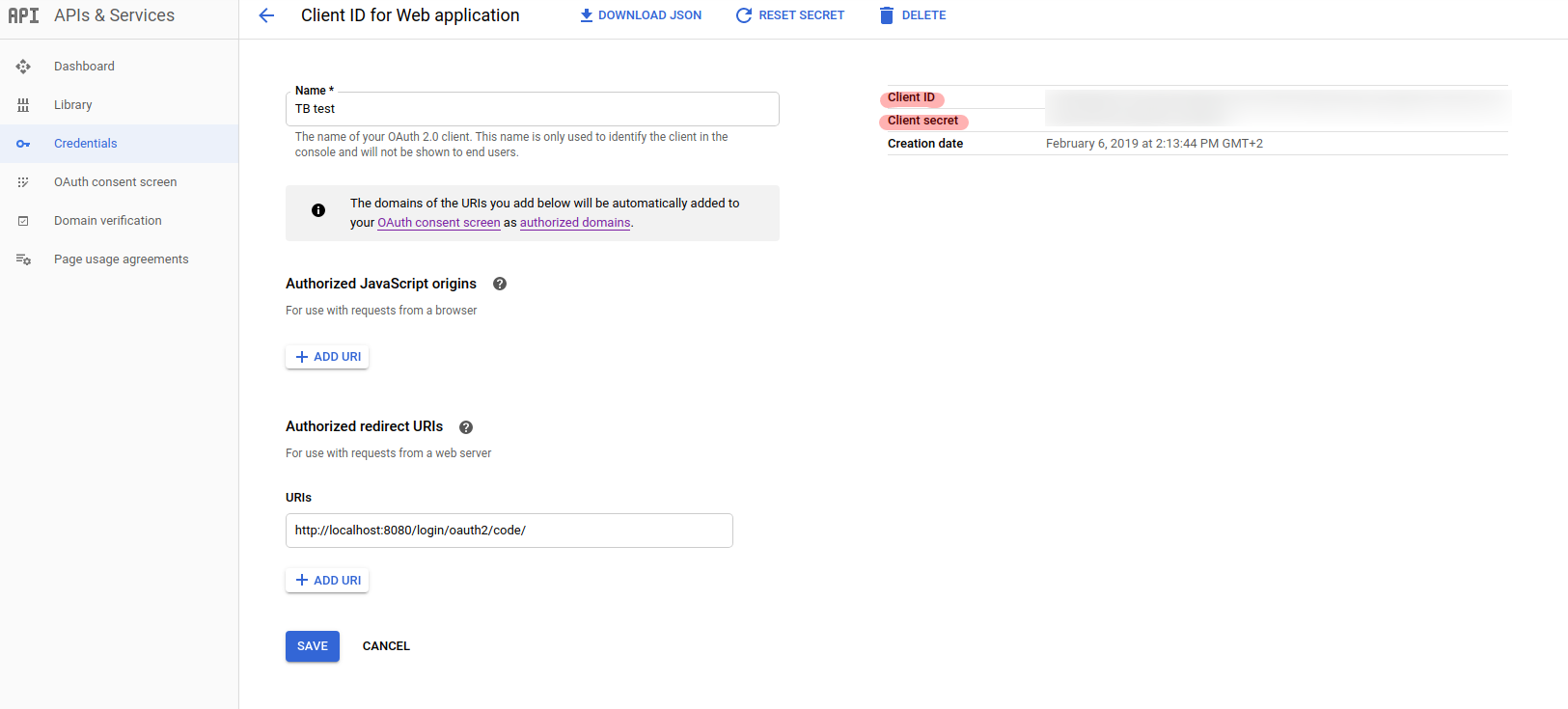
Please add to Authorized redirect URIs section default ThingsBoard redirect URI that we are going to use in this sample:
http://localhost:8080/login/oauth2/code/
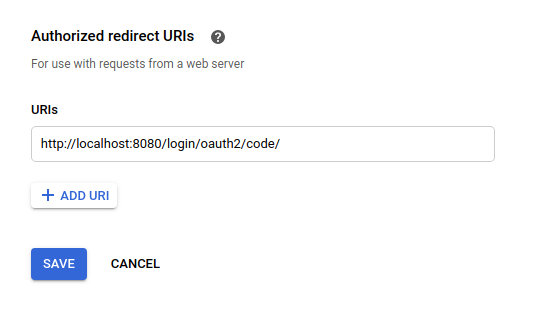
Configuration of ThingsBoard
You will need to modify OAuth 2.0 parameters in thingsboard.yml
# Security parameters
security:
...
oauth2:
# Enable/disable OAuth 2.0 login functionality
# For details please refer to https://thingsboard.io/docs/user-guide/oauth-2-support/
enabled: "${SECURITY_OAUTH2_ENABLED:false}"
# Redirect URL where access code from external user management system will be processed
loginProcessingUrl: "${SECURITY_OAUTH2_LOGIN_PROCESSING_URL:/login/oauth2/code/}"
# List of SSO clients
clients:
default:
# Label that going to be show on login button - 'Login with {loginButtonLabel}'
loginButtonLabel: "${SECURITY_OAUTH2_DEFAULT_LOGIN_BUTTON_LABEL:Default}"
# Icon that going to be show on login button. Material design icon ID (https://material.angularjs.org/latest/api/directive/mdIcon)
loginButtonIcon: "${SECURITY_OAUTH2_DEFAULT_LOGIN_BUTTON_ICON:}"
clientName: "${SECURITY_OAUTH2_DEFAULT_CLIENT_NAME:ClientName}"
clientId: "${SECURITY_OAUTH2_DEFAULT_CLIENT_ID:}"
clientSecret: "${SECURITY_OAUTH2_DEFAULT_CLIENT_SECRET:}"
accessTokenUri: "${SECURITY_OAUTH2_DEFAULT_ACCESS_TOKEN_URI:}"
authorizationUri: "${SECURITY_OAUTH2_DEFAULT_AUTHORIZATION_URI:}"
scope: "${SECURITY_OAUTH2_DEFAULT_SCOPE:}"
# Redirect URL that must be in sync with 'security.oauth2.loginProcessingUrl', but domain name added
redirectUriTemplate: "${SECURITY_OAUTH2_DEFAULT_REDIRECT_URI_TEMPLATE:http://localhost:8080/login/oauth2/code/}"
jwkSetUri: "${SECURITY_OAUTH2_DEFAULT_JWK_SET_URI:}"
# 'authorization_code', 'implicit', 'refresh_token' or 'client_credentials'
authorizationGrantType: "${SECURITY_OAUTH2_DEFAULT_AUTHORIZATION_GRANT_TYPE:authorization_code}"
clientAuthenticationMethod: "${SECURITY_OAUTH2_DEFAULT_CLIENT_AUTHENTICATION_METHOD:post}" # basic or post
userInfoUri: "${SECURITY_OAUTH2_DEFAULT_USER_INFO_URI:}"
userNameAttributeName: "${SECURITY_OAUTH2_DEFAULT_USER_NAME_ATTRIBUTE_NAME:email}"
mapperConfig:
# Allows to create user if it not exists
allowUserCreation: "${SECURITY_OAUTH2_DEFAULT_MAPPER_ALLOW_USER_CREATION:true}"
# Allows user to setup ThingsBoard internal password and login over default Login window
activateUser: "${SECURITY_OAUTH2_DEFAULT_MAPPER_ACTIVATE_USER:false}"
# Mapper type of converter from external user into internal - 'basic' or 'custom'
type: "${SECURITY_OAUTH2_DEFAULT_MAPPER_TYPE:basic}"
basic:
# Key from attributes of external user object to use as email
emailAttributeKey: "${SECURITY_OAUTH2_DEFAULT_MAPPER_BASIC_EMAIL_ATTRIBUTE_KEY:email}"
firstNameAttributeKey: "${SECURITY_OAUTH2_DEFAULT_MAPPER_BASIC_FIRST_NAME_ATTRIBUTE_KEY:}"
lastNameAttributeKey: "${SECURITY_OAUTH2_DEFAULT_MAPPER_BASIC_LAST_NAME_ATTRIBUTE_KEY:}"
# Strategy for generating Tenant from external user object - 'domain', 'email' or 'custom'
# 'domain' - name of the Tenant will be extracted as domain from the email of the user
# 'email' - name of the Tenant will email of the user
# 'custom' - please configure 'tenantNamePattern' for custom mapping
tenantNameStrategy: "${SECURITY_OAUTH2_DEFAULT_MAPPER_BASIC_TENANT_NAME_STRATEGY:domain}"
# %{attribute_key} as placeholder for attribute value of attributes of external user object
tenantNamePattern: "${SECURITY_OAUTH2_DEFAULT_MAPPER_BASIC_TENANT_NAME_PATTERN:}"
# If this field is not empty, user will be created as a user under defined Customer
# %{attribute_key} as placeholder for attribute value of attributes of external user object
customerNamePattern: "${SECURITY_OAUTH2_DEFAULT_MAPPER_BASIC_CUSTOMER_NAME_PATTERN:}"
# If this field is not empty, user will be created with default defined Dashboard
defaultDashboardName: "${SECURITY_OAUTH2_DEFAULT_MAPPER_BASIC_DEFAULT_DASHBOARD_NAME:}"
# If this field is set 'true' along with non-empty 'defaultDashboardName', user will start from the defined Dashboard in fullscreen mode
alwaysFullScreen: "${SECURITY_OAUTH2_DEFAULT_MAPPER_BASIC_ALWAYS_FULL_SCREEN:false}"
#
# NOTE: Next configurations available only in Professional Edition
#
# If this field is not empty, Customer will be created in the hierarchy under this parent Customer
# %{attribute_key} as placeholder for attributes value by key
parentCustomerNamePattern: "${SECURITY_OAUTH2_DEFAULT_MAPPER_BASIC_PARENT_CUSTOMER_NAME_PATTERN:}"
# User will be added to the All group of the owner and additional to all groups, provided in this list
# List of comma separated user group names, %{attribute_key} as placeholder for attributes value by key
userGroupsNamePattern: "${SECURITY_OAUTH2_DEFAULT_MAPPER_BASIC_USER_GROUPS_NAME_PATTERN:Tenant Administrators}"
custom:
url: "${SECURITY_OAUTH2_DEFAULT_MAPPER_CUSTOM_URL:}"
username: "${SECURITY_OAUTH2_DEFAULT_MAPPER_CUSTOM_USERNAME:}"
password: "${SECURITY_OAUTH2_DEFAULT_MAPPER_CUSTOM_PASSWORD:}"
Please modify this section with information (clientId and clientSecret) from your Google API console.
Use this link to see the list of up-to-date URLs like accessTokenUri, authorizationUri etc.
# Security parameters
security:
...
oauth2:
enabled: true
loginProcessingUrl: /login/oauth2/code/
clients:
default:
loginButtonLabel: Google
loginButtonIcon: mdi:google
clientName: TB Google test
clientId: XXXXXXXXXXXXXXXXXX
clientSecret: YYYYYYYYYYYYYYYYY
accessTokenUri: https://oauth2.googleapis.com/token
authorizationUri: https://accounts.google.com/o/oauth2/auth
scope: openid,email,profile
redirectUriTemplate: http://localhost:8080/login/oauth2/code/
jwkSetUri: https://www.googleapis.com/oauth2/v3/certs
authorizationGrantType: authorization_code
clientAuthenticationMethod: post
userInfoUri: https://openidconnect.googleapis.com/v1/userinfo
userNameAttributeName: email
mapperConfig:
type: basic
allowUserCreation: true
activateUser: false
basic:
emailAttributeKey: email
firstNameAttributeKey: given_name
lastNameAttributeKey: family_name
tenantNameStrategy: custom
tenantNamePattern:
customerNamePattern:
alwaysFullScreen: false
defaultDashboardName:
#
# NOTE: Next configurations available only in Professional Edition
#
parentCustomerNamePattern:
userGroupsNamePattern: Tenant Administators
custom:
url:
username:
password:
So that the resulted thingsboard.yml oauth2 configurations for Google will look similar to the provided below:
If we navigate to the Login screen, we will see additional Login option with Google:
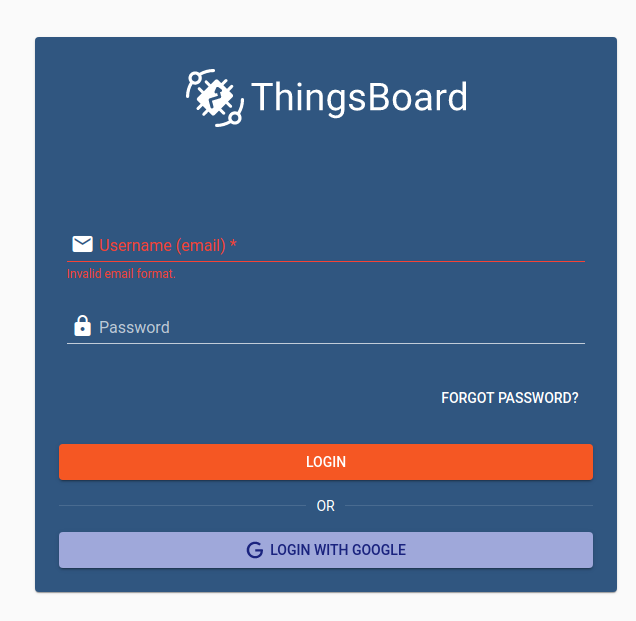
Once we click it and select on of our Google Account, we are going to be logged into ThingsBoard with our Google’s email as a Tenant Administrator email:
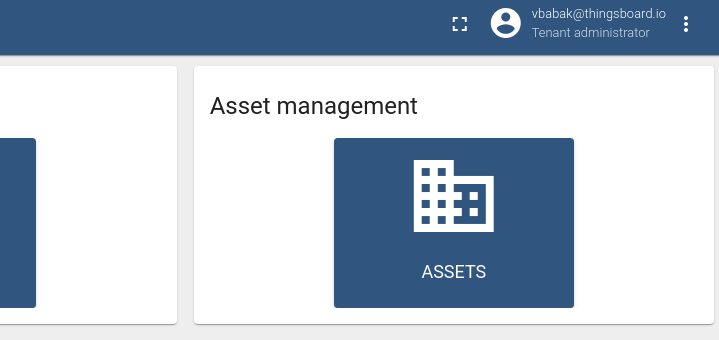
If you will login as the System Administrator, you will see that the Tenant name is our Google’s email, according to basic mapper:

Login with Auth0
Now let’s add one more SSO provider to our list - Auth0. This time we are going to create customers for our users inside a single domain tenant.
To use Auth0 authentication platform for Login, let’s create new application of ‘Regular Web App’ type following this link.
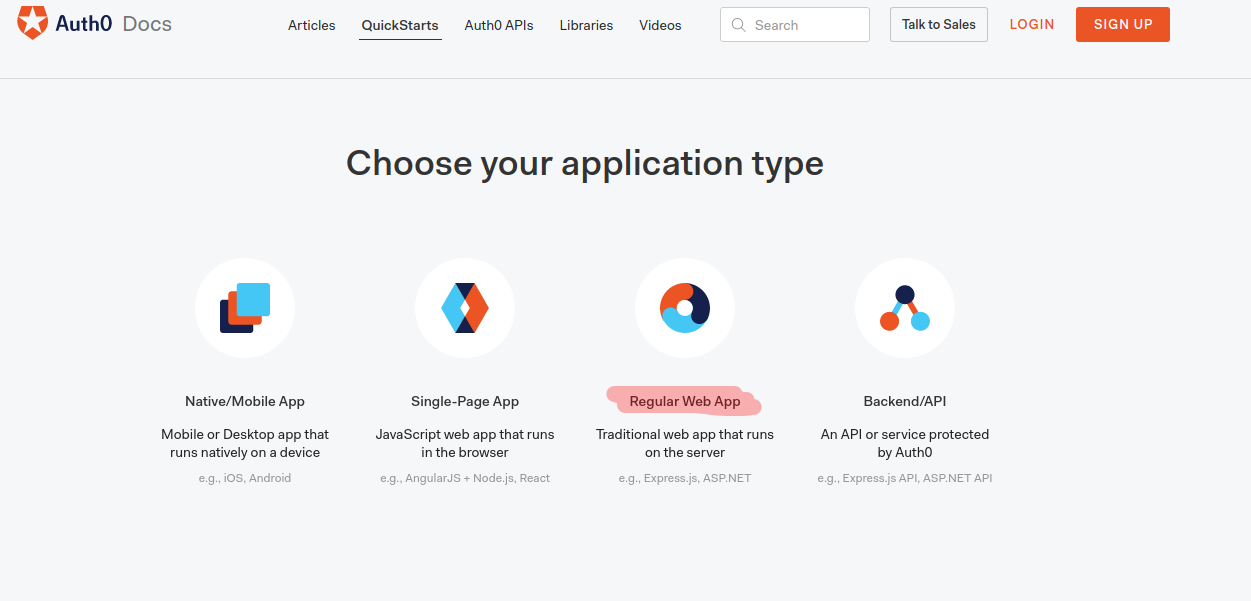
From the list of technology please select Java Spring Security:
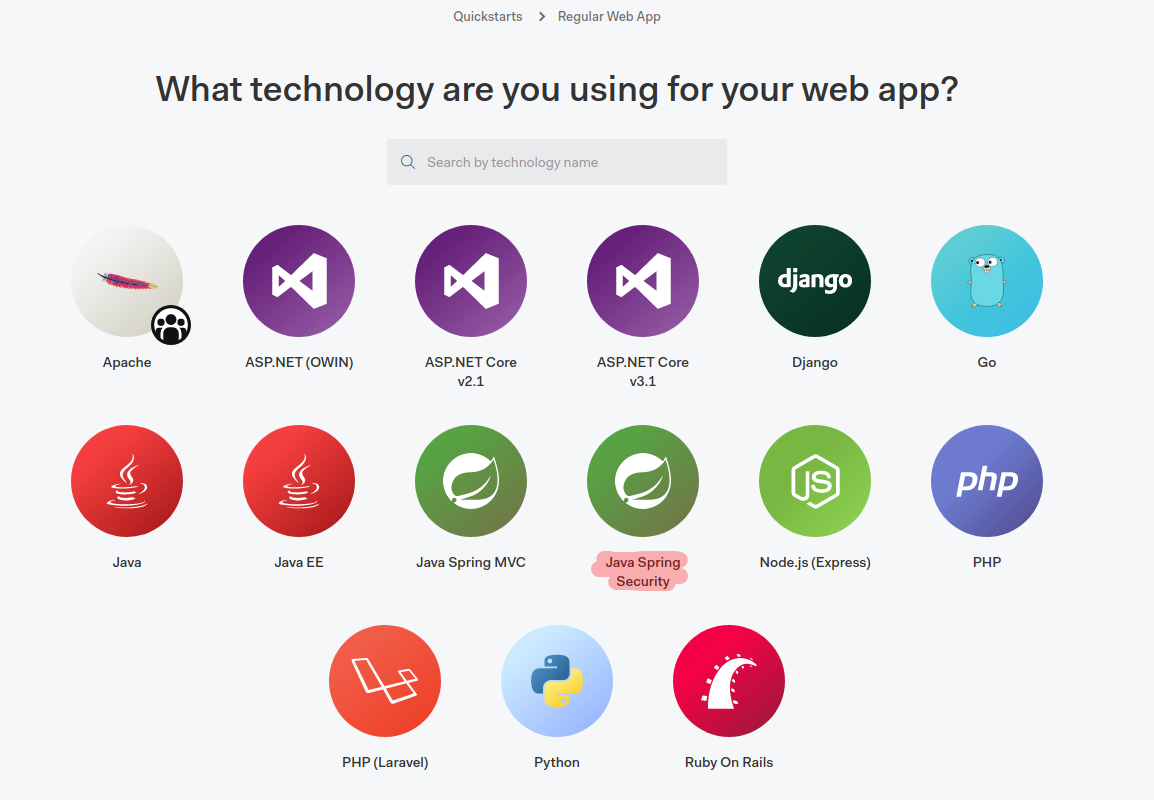
Once your application will be created you can navigate to application details to obtain clientId and clientSecret:
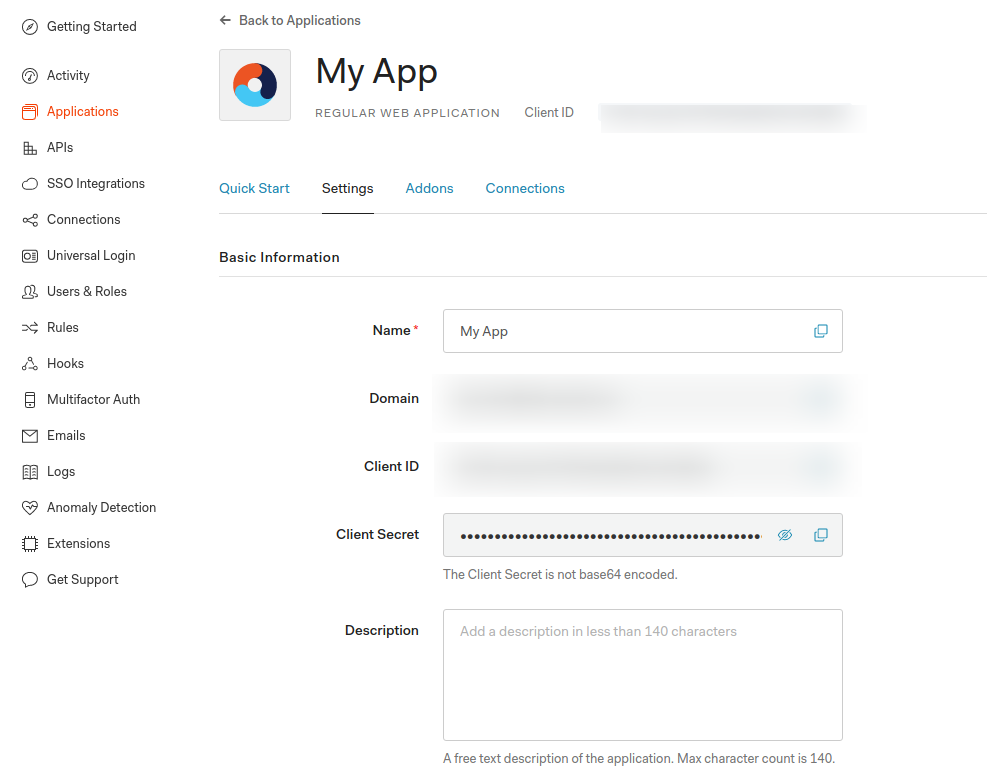
As well please update you allowed Callback URLs:
http://localhost:8080/login/oauth2/code/
Please, note that it is not necessary to update the Application login URI.
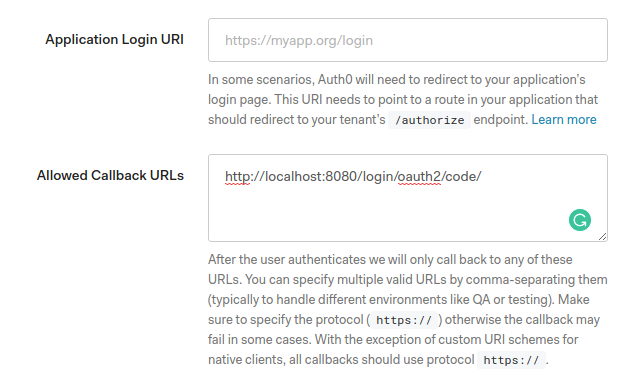
In the advanced details section you will be able to find all the required URLs (endpoints) for OAuth 2.0 configuration:
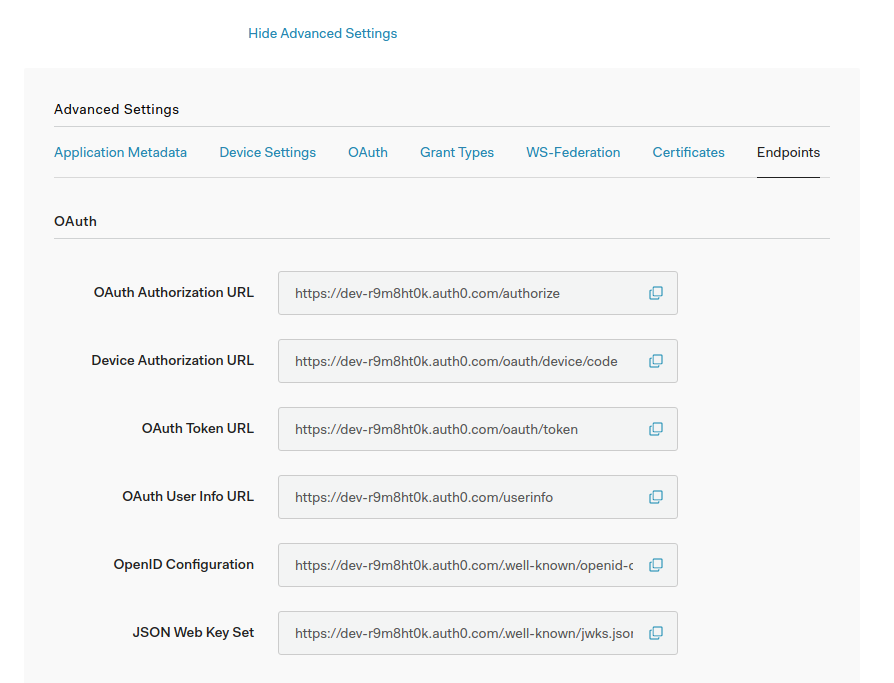
Configuration of ThingsBoard
Now it is time to update the thingsboard.yml with the additional SSO provider. This snippet contains both providers that are used in our sample:
# Security parameters
security:
...
oauth2:
enabled: true
loginProcessingUrl: /login/oauth2/code/
clients:
auth0:
loginButtonLabel: Auth0
loginButtonIcon: mdi:shield-account
clientName: My App
clientId: XXXXXXXXXXXXXXXXXXX
clientSecret: YYYYYYYYYYYYYYYYY
accessTokenUri: https://dev-jwnt7l67.auth0.com/oauth/token
authorizationUri: https://dev-jwnt7l67.auth0.com/authorize
scope: openid,email,profile
redirectUriTemplate: http://localhost:8080/login/oauth2/code/
jwkSetUri: https://dev-jwnt7l67.auth0.com/.well-known/jwks.json
authorizationGrantType: authorization_code
clientAuthenticationMethod: post
userInfoUri: https://dev-jwnt7l67.auth0.com/userinfo
userNameAttributeName: email
mapperConfig:
type: basic
allowUserCreation: true
activateUser: false
basic:
emailAttributeKey: email
firstNameAttributeKey:
lastNameAttributeKey:
tenantNameStrategy: domain
tenantNamePattern:
customerNamePattern: %{email}
#
# NOTE: Next configurations available only in Professional Edition
#
parentCustomerNamePattern:
userGroupsNamePattern: Customer Users
custom:
url:
username:
password:
So that the resulted thingsboard.yml oauth2 configurations for OAuth0 will look similar to the provided below:
If we navigate to Login screen, we will see two possible Login with options - Google and Auth0:
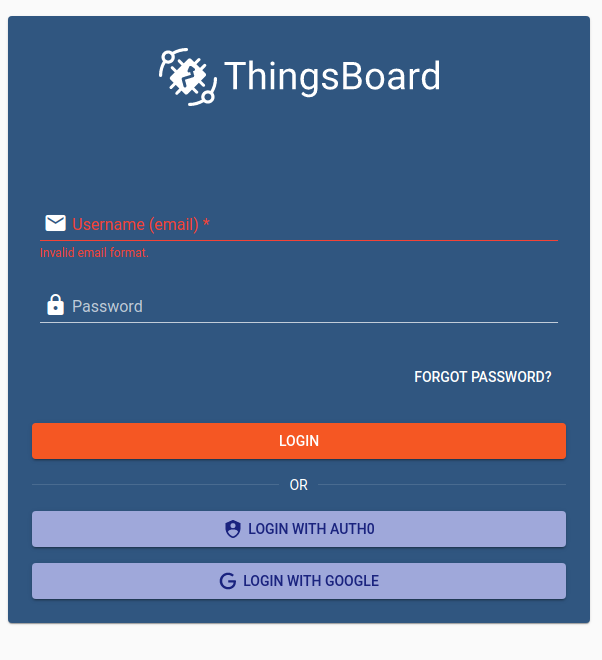
Once we click it and select our Auth0 Account, we are going to be logged into ThingsBoard with our email’s as Customer User:
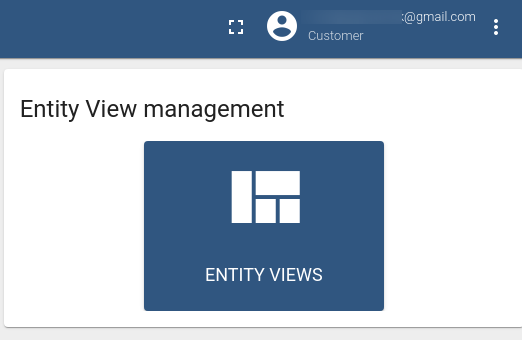
If we are logged as System Administrator, you will see that Tenant name is our Auth0 email domain name, according to basic mapper:

We have completed our sample and now your users not required to create accounts inside ThingsBoard - they can use already exist SSO providers for this.
Resulted Snipped
This snippet contains both providers that are used in our sample:
# Security parameters
security:
...
oauth2:
enabled: true
loginProcessingUrl: /login/oauth2/code/
clients:
google:
loginButtonLabel: Google
loginButtonIcon: mdi:google
clientName: TB Google test
clientId: XXXXXXXXXXXXXXXXXX
clientSecret: YYYYYYYYYYYYYYYYY
accessTokenUri: https://oauth2.googleapis.com/token
authorizationUri: https://accounts.google.com/o/oauth2/auth
scope: openid,email,profile
redirectUriTemplate: http://localhost:8080/login/oauth2/code/
jwkSetUri: https://www.googleapis.com/oauth2/v3/certs
authorizationGrantType: authorization_code
clientAuthenticationMethod: post
userInfoUri: https://openidconnect.googleapis.com/v1/userinfo
userNameAttributeName: email
mapperConfig:
type: basic
allowUserCreation: true
activateUser: false
basic:
emailAttributeKey: email
firstNameAttributeKey: given_name
lastNameAttributeKey: family_name
tenantNameStrategy: email
tenantNamePattern:
customerNamePattern:
alwaysFullScreen: false
defaultDashboardName:
#
# NOTE: Next configurations available only in Professional Edition
#
parentCustomerNamePattern:
userGroupsNamePattern: Tenant Administators
custom:
url:
username:
password:
auth0:
loginButtonLabel: Auth0
loginButtonIcon: mdi:shield-account
clientName: My App
clientId: XXXXXXXXXXXXXXXXXXX
clientSecret: YYYYYYYYYYYYYYYYY
accessTokenUri: https://dev-jwnt7l67.auth0.com/oauth/token
authorizationUri: https://dev-jwnt7l67.auth0.com/authorize
scope: openid,email,profile
redirectUriTemplate: http://localhost:8080/login/oauth2/code/
jwkSetUri: https://dev-jwnt7l67.auth0.com/.well-known/jwks.json
authorizationGrantType: authorization_code
clientAuthenticationMethod: post
userInfoUri: https://dev-jwnt7l67.auth0.com/userinfo
userNameAttributeName: email
mapperConfig:
type: basic
allowUserCreation: true
activateUser: false
basic:
emailAttributeKey: email
firstNameAttributeKey:
lastNameAttributeKey:
tenantNameStrategy: domain
tenantNamePattern:
customerNamePattern: %{email}
alwaysFullScreen: false
defaultDashboardName:
#
# NOTE: Next configurations available only in Professional Edition
#
parentCustomerNamePattern:
userGroupsNamePattern: Customer Users
custom:
url:
username:
password:
Mapping of external user into ThingBoard internal user structure
Mapping of the external user info object into ThingBoard user can be achieved in two ways - using the Basic and Custom mappers. Main functionality of the mapper is to map key-value attributes from the external user info object into expected structure of the ThingsBoard OAuth 2.0 User:
public class OAuth2User {
private String tenantName;
private TenantId tenantId;
private String customerName;
private CustomerId customerId;
private String email;
private String firstName;
private String lastName;
private boolean alwaysFullScreen;
private String defaultDashboardName;
// NOTE: Next configurations available only in Professional Edition
private List<String> userGroups;
private String parentCustomerName;
private CustomerId parentCustomerId;
}
Basic mapper
A basic mapper is able to merge external OAuth 2.0 user info object into ThingsBoard OAuth 2.0 user with a predefined set of rules. Configuration of this mapper done over the thingsboard.yml:
mapperConfig:
# Allows to create user if it not exists
allowUserCreation: "${SECURITY_OAUTH2_DEFAULT_MAPPER_ALLOW_USER_CREATION:true}"
# Allows user to setup ThingsBoard internal password and login over default Login window
activateUser: "${SECURITY_OAUTH2_DEFAULT_MAPPER_ACTIVATE_USER:false}"
# Mapper type of converter from external user into internal - 'basic' or 'custom'
type: "${SECURITY_OAUTH2_DEFAULT_MAPPER_TYPE:basic}"
basic:
# Key from attributes of external user object to use as email
emailAttributeKey: "${SECURITY_OAUTH2_DEFAULT_MAPPER_BASIC_EMAIL_ATTRIBUTE_KEY:email}"
firstNameAttributeKey: "${SECURITY_OAUTH2_DEFAULT_MAPPER_BASIC_FIRST_NAME_ATTRIBUTE_KEY:}"
lastNameAttributeKey: "${SECURITY_OAUTH2_DEFAULT_MAPPER_BASIC_LAST_NAME_ATTRIBUTE_KEY:}"
# Strategy for generating Tenant from external user object - 'domain', 'email' or 'custom'
# 'domain' - name of the Tenant will be extracted as domain from the email of the user
# 'email' - name of the Tenant will email of the user
# 'custom' - please configure 'tenantNamePattern' for custom mapping
tenantNameStrategy: "${SECURITY_OAUTH2_DEFAULT_MAPPER_BASIC_TENANT_NAME_STRATEGY:domain}"
# %{attribute_key} as placeholder for attribute value of attributes of external user object
tenantNamePattern: "${SECURITY_OAUTH2_DEFAULT_MAPPER_BASIC_TENANT_NAME_PATTERN:}"
# If this field is not empty, user will be created as a user under defined Customer
# %{attribute_key} as placeholder for attribute value of attributes of external user object
customerNamePattern: "${SECURITY_OAUTH2_DEFAULT_MAPPER_BASIC_CUSTOMER_NAME_PATTERN:}"
# If this field is not empty, user will be created with default defined Dashboard
defaultDashboardName: "${SECURITY_OAUTH2_DEFAULT_MAPPER_BASIC_DEFAULT_DASHBOARD_NAME:}"
# If this field is set 'true' along with non-empty 'defaultDashboardName', user will start from the defined Dashboard in fullscreen mode
alwaysFullScreen: "${SECURITY_OAUTH2_DEFAULT_MAPPER_BASIC_ALWAYS_FULL_SCREEN:false}"
#
# NOTE: Next configurations available only in Professional Edition
#
# If this field is not empty, Customer will be created in the hierarchy under this parent Customer
# %{attribute_key} as placeholder for attributes value by key
parentCustomerNamePattern: "${SECURITY_OAUTH2_DEFAULT_MAPPER_BASIC_PARENT_CUSTOMER_NAME_PATTERN:}"
# User will be added to the All group of the owner and additional to all groups, provided in this list
# List of comma separated user group names, %{attribute_key} as placeholder for attributes value by key
userGroupsNamePattern: "${SECURITY_OAUTH2_DEFAULT_MAPPER_BASIC_USER_GROUPS_NAME_PATTERN:Tenant Administrators}"
To use basic mapper please set mapperConfig.type or SECURITY_OAUTH2_DEFAULT_MAPPER_TYPE environment variable to basic.
Here are the details of other properties:
-
allowUserCreation If this option set to true, then if user account does not exist in the ThingsBoard yet, it will be created. If this option set to false, user will get access denied error if will try to login with an external OAuth 2.0 provider, but there is no user exists with those credentials in the ThingsBoard.
-
emailAttributeKey This is the key of the attributes from the external OAuth 2.0 user info that is going to be used as ThingsBoard user email property.
-
firstNameAttributeKey This is the key of the attributes from the external OAuth 2.0 user info that is going to be used as ThingsBoard user first name property.
-
lastNameAttributeKey This is the key of the attributes from the external OAuth 2.0 user info that is going to be used as ThingsBoard user surname property.
- tenantNameStrategy
This option specifies which tenant is going to be chosen for creating of the user.
A basic mapper provide three possible options strategy for generating Tenant name from external user info object - domain, email or custom.
- domain - name of the Tenant will be extracted as domain from the email of the user
- email - name of the Tenant will email of the user
- custom - you can define a custom pattern for Tenant name. Please see tenantNamePattern.
-
tenantNamePattern In case if the tenantNameStrategy is custom you can specify a name of the Tenant where user is going to be created with a help of custom pattern. You can use attributes from the external user info object to put them into the Tenant’s name. Please use %{attribute_key} as placeholder for attribute value.
Tenant pattern examples:
- Demo Tenant # Hard coded Tenant name
- Demo Tenant %{email} # In this case if user’s email is test@demo.com, Tenant’s name will be the ‘Demo Tenant test@demo.com’
- %{givenName} # In this case if user’s givenName attribute is Demo User, Tenant name will be ‘Demo User’
-
customerNamePattern User can be created under specific Customer, and not under the Tenant, if this pattern field is not empty. You can use attributes from the external user info object to put them into the Customer name. Please use %{attribute_key} as placeholder for attribute value.
Customer pattern examples:
- Demo Customer # Hard coded Customer name
- Demo Customer %{email} # If user’s email attribute is test@demo.com, Customer name is going to be ‘Demo Customer test@demo.com’
- %{city} # If user’s city attribute is New York, Customer name is going to be ‘New York’
-
defaultDashboardName User will be redirected to specific Dashboard, if this field is not empty.
-
alwaysFullScreen If this field is true and defaultDashboardName is not empty, User will be redirected to specific Dashboard in fullscreen mode.
-
parentCustomerNamePattern
NOTE: This configuration available only in Professional Edition
Customer of the user can be created in the hierarchy under this parent Customer, if this pattern field is not empty. You can use attributes from the external user info object to put them into Parent Customer name. Please use %{attribute_key} as placeholder for attribute value.
Parent Customer pattern examples:
- Demo Parent Customer # Hard coded Parent Customer name
- Demo Parent Customer %{email} # If user’s email attribute is test@demo.com, Parent Customer name is going to be ‘Demo Parent Customer test@demo.com’
- %{country} # If user’s country attribute is Top Customer, Parent Customer name is going to be ‘Parent Customer’
-
userGroupsNamePattern
NOTE: This configuration available only in Professional Edition
By default, newly created user will be assigned only to the All user’s group. You can customize this behaviour by specifying list of groups, where user must be assigned to as well. You can use attributes from the external user info object to put them into user group names. Please use %{attribute_key} as placeholder for attribute value. If groups doesn’t exist, this group will be created automatically.
User groups pattern examples:
- Tenant Administrators, Managers # Hard coded user groups
- %{job_title} # If user’s job_title attribute is Manager, user is going to be assigned into Manager user group.
Custom mapper
If basic mapper functionality doesn’t cover your business needs, with the help of custom mapper you are able to add an implementation that fits your specific goals.
A custom mapper designed as a separate microservice which is running nearby the ThingsBoard core microservice. ThingsBoard forwards all mapping requests to this microservice and expects as a response ThingsBoard OAuth 2.0 user object:
public class OAuth2User {
private String tenantName;
private TenantId tenantId;
private String customerName;
private CustomerId customerId;
private String email;
private String firstName;
private String lastName;
private boolean alwaysFullScreen;
private String defaultDashboardName;
// NOTE: Next configurations available only in Professional Edition
private List<String> userGroups;
private String parentCustomerName;
private CustomerId parentCustomerId;
}
Please refer to this base implementation as a starting point for your custom mapper.
Configuration of this mapper done over thingsboard.yml:
mapperConfig:
# Allows to create user if it not exists
allowUserCreation: "${SECURITY_OAUTH2_DEFAULT_MAPPER_ALLOW_USER_CREATION:true}"
# Allows user to setup ThingsBoard internal password and login over default Login window
activateUser: "${SECURITY_OAUTH2_DEFAULT_MAPPER_ACTIVATE_USER:false}"
# Mapper type of converter from external user info object into internal - 'basic' or 'custom'
type: "${SECURITY_OAUTH2_DEFAULT_MAPPER_TYPE:custom}"
custom:
url: "${SECURITY_OAUTH2_DEFAULT_MAPPER_CUSTOM_URL:}"
username: "${SECURITY_OAUTH2_DEFAULT_MAPPER_CUSTOM_USERNAME:}"
password: "${SECURITY_OAUTH2_DEFAULT_MAPPER_CUSTOM_PASSWORD:}"
To use custom mapper please set mapperConfig.type or SECURITY_OAUTH2_DEFAULT_MAPPER_TYPE environment variable to custom.
Here are the details of other properties:
-
url
Url of the custom mapper endpoint.
-
username
If custom mapper endpoint configured with a basic authorization, specify username in this property.
-
password
If custom mapper endpoint configured with a basic authorization, specify password in this property.
Here is the example of demo configuration:
custom:
url: http://localhost:10010/oauth2/mapper
username: admin
password: pa$$word
OAuth 2.0 configuration parameters
| Key | Description |
|---|---|
| security.oauth2.enabled | Enable/disable OAuth 2.0 login functionality |
| security.oauth2.loginProcessingUrl | Redirect URL where access code from external user management system will be processed |
| security.oauth2.clients.default.loginButtonLabel | Label that going to be show on login button - ‘Login with {loginButtonLabel}’ |
| security.oauth2.clients.default.loginButtonIcon | Icon that going to be show on login button. Material design icon ID. List of icon IDs could be found here |
| security.oauth2.clients.default.clientName | Logical name of the client or registration |
| security.oauth2.clients.default.clientId | Client ID |
| security.oauth2.clients.default.clientSecret | Client secret |
| security.oauth2.clients.default.accessTokenUri | URI for the token endpoint |
| security.oauth2.clients.default.authorizationUri | URI for the authorization endpoint |
| security.oauth2.clients.default.scope | Sets the scope(s) used for the client |
| security.oauth2.clients.default.redirectUriTemplate | URI (or uri template) for the redirection endpoint. Must be in sync with ‘security.oauth2.loginProcessingUrl’ (domain name added) |
| security.oauth2.clients.default.jwkSetUri | URI for the JSON Web Key (JWK) Set endpoint |
| security.oauth2.clients.default.authorizationGrantType | Authorization grant type used for the client |
| security.oauth2.clients.default.clientAuthenticationMethod | Authentication method used when authenticating the client with the authorization server |
| security.oauth2.clients.default.userInfoUri | URI for the user info endpoint |
| security.oauth2.clients.default.userNameAttributeName | Attribute name used to access the user’s name from the user info response |
HaProxy configuration
If ThingsBoard is running under loadbalancer like HAProxy please configure properly balance algorithm to make sure that the correct session is available on the ThingsBoard instance:
backend tb-api-backend
...
balance source # balance must be set to 'source'
...
As well please configure properly ACL mapping for HTTP and HTTPs requests:
frontend http-in
...
acl tb_api_acl path_beg /api/ /swagger /webjars /v2/ /static/rulenode/ /oauth2/ /login/oauth2/ # '/oauth2/ /login/oauth2/' added
...
frontend https_in
...
acl tb_api_acl path_beg /api/ /swagger /webjars /v2/ /static/rulenode/ /oauth2/ /login/oauth2/ # '/oauth2/ /login/oauth2/' added
...